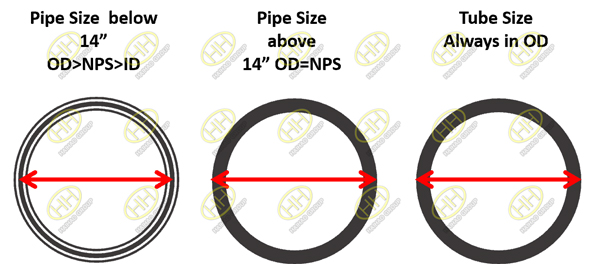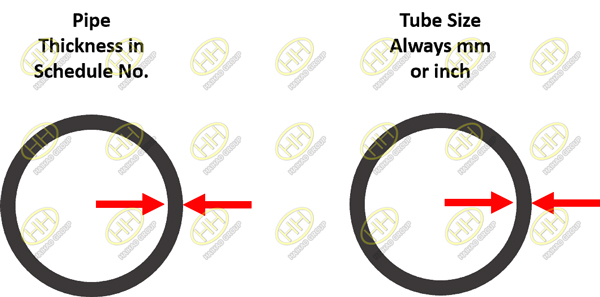Five difference between pipe and tube
To an outsider, pipes and tubes may seem like they should be synonymous. To a marine engineer, the measurements, standards and language used to distinguish the two are quite different. In fact, differences in nomenclature and measurements could cause quite the headache if tubes and pipes were mistakenly assumed to be interchangeable.
1.Difference in the way size mentioned
American code & Standard related to oil & gas such as ASME B31.3 Process Piping code & ASME section IX Pressure vessel design code use the term NPS – Nominal Pipe Size to define the diameter of the pipe.Whereas in the case of Tube, tube size is defined infix number either in mm or inches.

Difference in the way size mentioned
2.Difference in the way thickness mentioned
Pipe thickness is specified in schedule number whereas tube thickness is specified in fix number either in mm or inches.

Difference in the way thickness mentioned
| PIPES | TUBES | |
| Size | Pipe Size Specified in Nominal Pipe Size (NPS) or Nominal Bore (NB) or Diameter Nominal (DN) | Tubes sized are specified in millimeter or in inches by outside diameter |
| Thickness | Wall thickness is expressed in schedule number | Wall thickness is expressed in millimeter, or inches, or BWG (Birmingham wire gauge.) |
| Diameter | The outside diameter of pipe up to size 12″ are numerically larger than corresponding pipe size | Outside diameter of tubes is numerically equal to the corresponding size. |
| Use | Used in all process & utility lines | Generally used in tracing lines, tubes for heat exchanger & fired heater & in instrument connection. |
| Also used as a structural member | Also used as a structural member | Also used as a structural member |
| Availability | Available in the small bore as well as the big bore. | Normally small-bore tube is used in process piping. For structural use, tubs are available in custom sizes. |
3.Difference in the way OD mentioned
Few other things you have to know is that up to 12″ NPS pipe outside diameter of the pipe is more than 12″ and above 12″, it is same as pipe size. Whereas for the tube outside diameter is always equal to the size of the tube. The 2nd thing that you have to keep in mind is that outside diameter of both pipe & tube is standardized so whenever thickness change inside diameter will change.

Difference in the way OD mentioned
4.Difference in Use of Pipe & Tube in Oil & Gas
As said earlier, pipes are used in all kind of process fluids and services. Tubes are generally used for heat transfer application such as heat tracing line, heat exchanger and fired heater and also used as instrument connection line. Tubes are also used as primary load bearing member in steel structure for the civil application.
5.Availability in the Sizes
Pipes are available in standard size of 1/8″ to 80″,whereas tubes used in oil & gas generally of small size. Structural tubular are available in all desired size.
As a professional piping supplier,we can supply both tubes and pipes in different specifications,standards,materials.If you want to know more about our products,please feel free to contact us.Email:sales@haihaogroup.com
